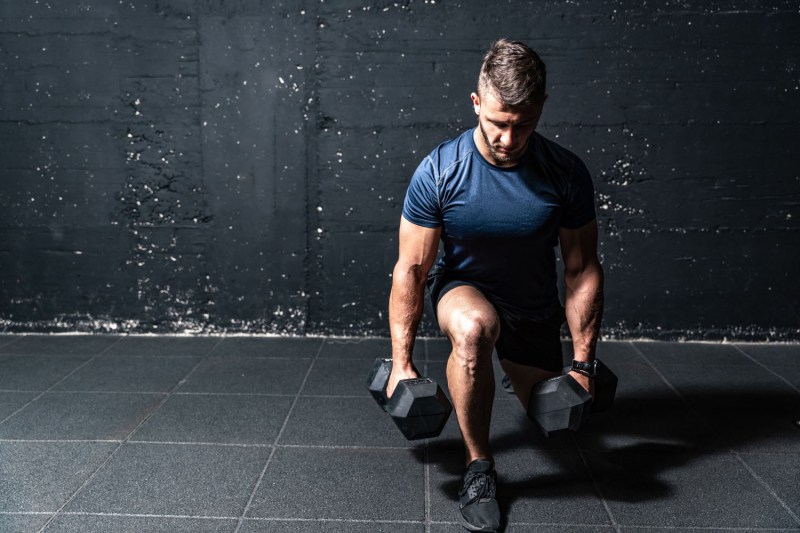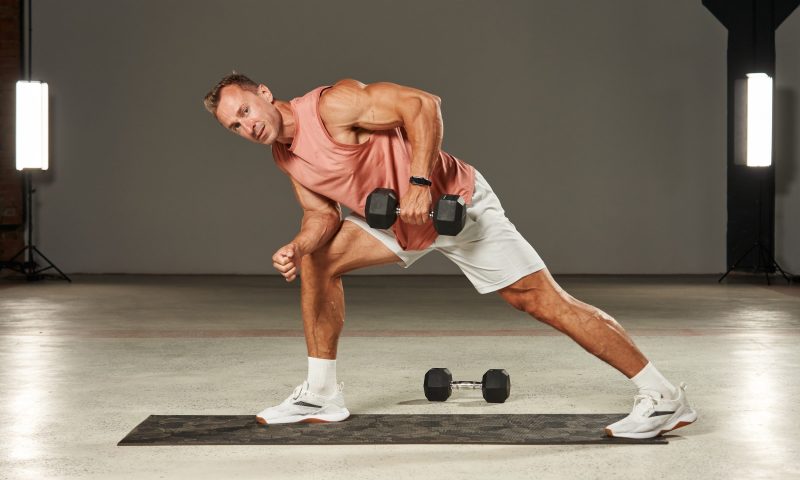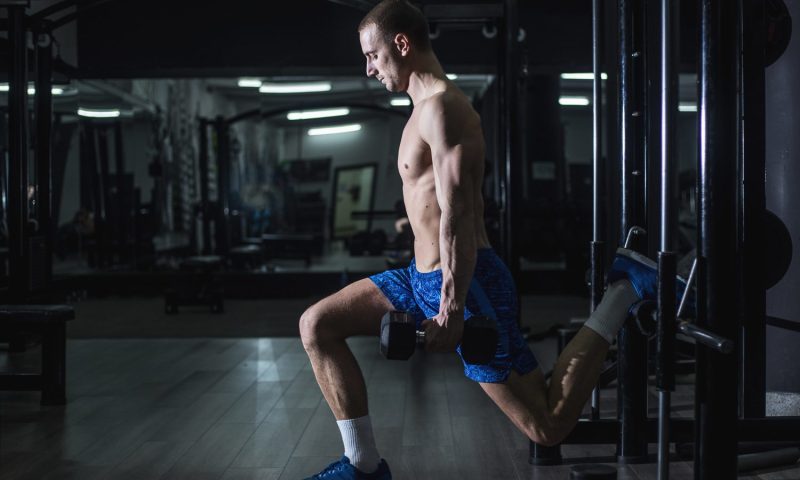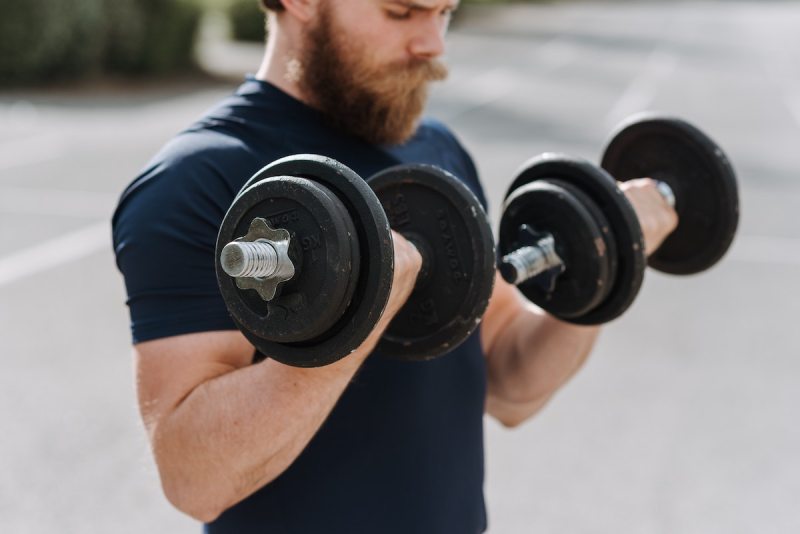You can work your whole body from the comfort and privacy of home with a pair of dumbbells. While gym machines, kettlebells, resistance bands, and other gym equipment definitely have their benefits and uses, sometimes keeping it simple with two dumbbells is the way to go.
My first home workout equipment was a humble yoga mat and a pair of adjustable dumbbells. It allowed me to ease my way into it. A full-body dumbbell workout is an efficient way to fire up all of your major muscle groups, which is excellent news for those of us with a busy schedule. Let’s look at the ultimate full-body dumbbell workout and the benefits of using dumbbells.
The benefits of using dumbbells in your workout

Here are some of the benefits of using dumbbells in your workout:
- Workout from the comfort and privacy of home.
- No need to head to the gym.
- You typically have a greater range of motion with dumbbells compared to barbells, so you can engage your muscles more fully and improve your balance and stability.
- Dumbbells are versatile equipment.
- Isolate with unilateral exercises, such as only working one arm at a time with a bicep curl.
- Build strength and lean muscle mass.
- Boost your stamina and endurance, and try longer workout sessions.
- Improve your cardiovascular health and fitness.
- Weight lifting with dumbbells can increase your bone density and lower the risk of osteoporosis.
- Weight training with dumbbells contributes to weight loss.
- Improve your posture and flexibility.
- Correct muscular imbalances.
Why do full-body workouts?

Full-body workouts often involve compound movements that allow you to accomplish more in less time. Compound exercises use more than one muscle group at a time. One study revealed that programs using compound movements or “multi-joint exercises” are typically more efficient for boosting muscle strength and maximal oxygen consumption compared to programs that mostly involve single-joint exercises. Examples of compound moves include squats, deadlifts, and lunges.
Research reveals that both full-body and split-body training protocols effectively improve body composition and strength over four weeks. Researchers concluded that the full-body workout program burned nearly three times as much fat mass.
Many fitness professionals and influencers like Alex Crockford and virtual trainer Bully Juice prefer a short and efficient full-body routine that works most major muscle groups in a short amount of time. You’ll also increase your VO2 max, burn fat, and torch calories.
The ultimate full-body dumbbell workout

Here are some of the best dumbbell exercises to target every major muscle group. If you have adjustable dumbbells or more than one pair available, you can increase or decrease the weight depending on the exercise or you can change your reps. Choose a weight that’s challenging but still allows you to maintain proper form. If you’re a beginner, start with lighter weights until you’re familiar with the exercise.
If you incorporate this routine into your schedule two or three times every week, you should level up your fitness and see results over time. Make sure your muscles have enough time to repair and recover, so don’t forget your rest days. After a quick 5-minute warm-up, you can start weight training.
Warm-up

Try a light warm-up with stretches like a tricep stretch and a hamstring stretch, followed by gentle mobility drills like jumping jacks and bodyweight squats. The goal with any warm-up is to start increasing blood flow to your muscles and loosening up any muscle tension before you start lifting weights and doing resistance training. Resistance training refers to exercises involving the use of external resistance, such as dumbbells, kettlebells, or gym machines.
Dumbbell halo

The dumbbell halo gets its name because you slowly move the dumbbell around the top of your head as if you’re drawing a halo. You’ll work your deltoid muscles in your shoulders as well as your upper trapezius, levator scapulae, rhomboids, serratus anterior, and forearms. You’ll also boost shoulder mobility and strengthen and engage your core.
Aim for 2 or 3 sets of 8 to 10 reps.
How to do the dumbbell halo:
- Stand with your feet about shoulder distance apart.
- Hold one dumbbell at chest level with your hands on either side of the dumbbell.
- Slowly move the dumbbell around the top of your head in a circular motion as if you’re drawing a halo above your head.
- Reverse the direction to bring the dumbbell back to the starting position.
- Repeat until you complete the set.
Tip: Avoid arching your lower back.
Goblet squat

With the goblet squat, you hold the weight in front of you with both hands as you squat down. This move improves your balance and stability. Research shows it can also enhance jumping capabilities. You’ll work your core, glutes, legs, and major muscle groups in your lower body.
Aim for 3 sets of 6 to 10 reps, depending on your fitness level.
How to do a goblet squat:
- Stand with your feet a little wider than hip-width apart.
- Angle your toes slightly outward.
- Use both hands to grip the handles of the dumbbell as if you were a king cupping a goblet.
- Position the weight in the middle of your chest with your elbows bent.
- Keep your core engaged and your spine neutral, and focus straight ahead.
- Bend your knees to dip down into the squat, keeping the weight close to your body.
- Ideally, you want your hips to be parallel with your knees.
- At the lowest point of your goblet squat, your elbows should touch the inside of your knees.
- Press down with the heels of your feet and lift yourself back up to the starting position.
- Repeat until you complete the set.
Military press

The military press is a compound weight training move that primarily targets your shoulder deltoids and works your pectoral muscles in your chest, your triceps in the back of your upper arms, and your trapezius muscles in your upper back. You press the dumbbells over your head straight up in the air and bring them back down again. The military press is an excellent upper-body move to bulk up your shoulders, back, and triceps.
Aim for 2 or 3 sets of 8 to 12 reps, depending on your fitness level.
How to do the military press:
- Stand with your feet about shoulders-distance apart.
- Grip the dumbbells with your hands a little wider than shoulder-width apart and your palms facing down.
- Squeeze your shoulder blades, glutes, and abs. Your knees should be slightly bent.
- Lift the weights to your shoulders and ensure your forearms are straight and perpendicular to the ground.
- Engage your core and push the dumbbells up vertically over your head, straightening your arms.
- Hold the position for a moment.
- Carefully lower the weights back down to your shoulders.
- Repeat until you complete the set.
Tip: Avoid locking your elbows or arching your back.
Bent-over row

The bent-over dumbbell row improves bone density, spinal stability, posture, and more. You’ll target multiple muscle groups, including your lats, rhomboids, and traps in your upper back, rear deltoids in your shoulders, biceps, glutes, and your lower back and core.
Aim for 3 to 4 sets of 8 to 10 reps.
Here’s how to do the bent-over row with two dumbbells:
- Start standing up with your feet about shoulder-width apart.
- Hold a dumbbell in both hands with your palms facing each other.
- Bend your knees slightly and engage your core.
- Try to keep your back straight and bring your hips behind your heels into the bent-forward position for the bent-over row. Ideally, your torso should be at a 45-degree angle, and your arms should be straight down.
- Carefully row the dumbbells upward toward your hips.
- Squeeze your shoulder blades together and pause for a moment here at the top of the movement.
- Return the dumbbells back down to the starting position.
- Repeat until you complete the set.
Tip: If you prefer, you can work one arm at a time.
Single-leg Romanian dumbbell deadlift

The dumbbell Romanian deadlift or RDL is a strength training compound exercise that targets and rehabilitates muscles along your posterior chain, including your legs, glutes, and lower back. You’ll fire up your hamstrings in the back of your thighs and your adductor muscles in your inner thighs. You can perform RDLs with one or two dumbbells.
How to do the dumbbell Romanian deadlift:
- Start standing with your feet about hip-width apart and your toes pointing straight ahead. Hold the dumbbells in front of your thighs with a closed overhand grip. Your palms should be facing your thighs.
- Hinge at your hips, engage your core, and push your hips back.
- With a slight bend in your knees, start lowering the dumbbells down along your legs with control. Keep the dumbbells close to your body.
- Lower the dumbbells until you feel a sufficient stretch in your hamstrings on the back of your thighs.
- Bring your hips forward and bring the dumbbells back up to return to the starting position.
- Repeat until you complete the set.
Dumbbell bench press

The classic bench press boosts your upper body strength and helps you grow muscle. You’ll work your pectoralis major and minor in your chest, your anterior and lateral shoulder deltoids, and your triceps and biceps in your arms.
Aim for 3 sets of 5 to 10 reps.
How to do a dumbbell bench press:
- Lay flat on your back on a bench and hold a pair of dumbbells on your hips or just above your knees.
- Engage your core and glutes.
- Extend your arms to lift the dumbbells above your chest to the starting position.
- Squeeze your shoulder blades to lower the dumbbells down until your elbows are bent and your arms form a 90-degree angle. Your upper arms should be parallel to the floor.
- Contract your chest, keep your core engaged, and press the dumbbells back up to the starting position.
- Repeat until you complete the set.
Tip: Avoid arching your back.
Dumbbell Bulgarian split squat

With the Bulgarian split squat, your back foot is raised off the ground on some type of platform, bench, or sturdy chair. Split squats involve a lunge position with one foot forward and the other behind you, allowing you to reach a greater squat depth to work your legs and core. Bulgarian split squats are a killer move to scorch those quads in your thighs. You’ll also work your calves, glutes, hamstrings, and adductors.
Aim for 2 or 3 sets of 8 to 10 reps on either side. If you’re a beginner, go with a lighter weight and try one set for now until you develop strength and become more familiar with the exercise.
How to do Bulgarian split squats:
- Start by standing in front of a step, chair, or bench facing away from the step with your feet about hips-distance apart. You should be about 2 feet away from the step.
- Lift your right leg and place the top of your right foot on the step.
- Make sure your feet are still about hips-width apart and engage your core.
- Bend your left knee and lower yourself as if moving down into the lunge position.
- Pause for a moment at the bottom of the movement.
- Drive back up to your starting position with control.
- Repeat until you complete the set before switching to the other leg.
Dumbbell bicep curl

As the name suggests, the bicep curl is an effective move for bulging your biceps on the front of your upper arms. You’ll also engage your forearms, brachioradialis muscle, brachialis muscle under your biceps muscle, your forearms, and shoulder deltoids. You’ll need to engage your core to stabilize your upper body. The goal is to lift the load by bending your elbow to curl the weight up near your shoulders.
Aim for 3 to 4 sets of 6 to 12 reps, depending on your fitness level and goals.
How to do the bicep curl:
- Stand with your feet about hips-distance apart.
- Hold a pair of dumbbells with your palms facing each other.
- Curl the dumbbell up near your shoulders by moving only at your elbow joint.
- When you’re curling up, rotate the dumbbell inward until your palm is facing upward.
- Squeeze your biceps at the top of the movement.
- Lower the weights back down to the starting position with control.
- Repeat until you complete the set.
Additional dumbbell exercises to try

Try these dumbbell moves when you’re ready to switch up your routine:
- Dumbbell rear-delt fly
- Dumbbell farmer’s carry
- Dumbbell renegade row
- Dumbbell seated Russian twist
- Dumbbell lateral raises
FAQs

Can I get a full-body workout with just dumbbells?
You can get a full-body workout using just dumbbells, which is more accessible and convenient for many people. You can try a wide variety of dumbbell movements to enhance your fitness, such as dumbbell squats or dumbbell renegade rows.
Are 20-pound dumbbells enough?
The right weight for you depends on several factors, such as your goals and fitness level. Generally speaking, you can perform plenty of exercises with 20-pound dumbbells and still get a good workout, especially compound exercises that work multiple muscle groups simultaneously. Research indicates that lower training intensities and loads performed at higher frequencies with little to no equipment can still improve functional ability and strength. Using 20-pound dumbbells regularly and doing the right exercises should still generate results.
What is the 6-12-25 dumbbell workout plan?
The 6-12-25 dumbbell workout plan involves performing 6 reps of an exercise followed by 12 reps, followed by 25 reps. The idea is to lift a heavy weight you can only lift 6 times without compromising your form. Next, you drop down to a weight you can only lift for 12 reps before dropping down to a weight you can only lift for 25 reps.
How effective is a full-body dumbbell workout?
Full-body dumbbell workouts are effective for building muscle and strength, so it’s worth making room in your schedule. After you perfect your technique and become familiar with the exercise, you can incorporate progressive overload, where you gradually increase the weight you use over time to develop muscle power.




